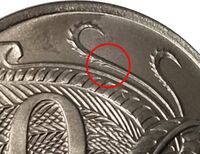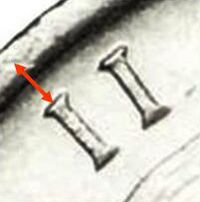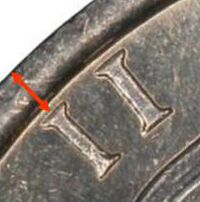Australian ten-cent coin: Difference between revisions
No edit summary |
|||
| (37 intermediate revisions by the same user not shown) | |||
| Line 1: | Line 1: | ||
__FORCETOC__ | |||
=== Production === | |||
The ten-cent coin was first introduced as part of Australia's transition to decimal currency on February 14, 1966. This transition marked a significant change in the nation's monetary system, moving away from the pounds, shillings, and pence system to a more straightforward decimal system. | |||
The original reverse design of the ten-cent coin features a lyrebird, an iconic Australian bird known for its extraordinary ability to mimic natural and artificial sounds. Remarkably, this design has remained unchanged since its introduction, making it a consistent and recognizable symbol on the coin. | |||
While the reverse design has stayed the same, the obverse design underwent a notable alteration in 2016. This change was made to commemorate the 50th anniversary of the introduction of decimal currency in Australia. However, the steadfast lyrebird on the reverse side continues to grace the ten-cent coin, preserving a piece of the original design for collectors and the general public alike. | |||
The production of the ten-cent coin began with the first issues in 1966, all of which were minted at the Royal Mint in London. Following this initial production run, the responsibility for minting ten-cent coins shifted to the Royal Australian Mint in Canberra. This transition reflects the evolving nature of coin production and the collaborative efforts between different mints to ensure the availability of ten-cent coins for circulation in Australia. | |||
{| class="wikitable" | {| class="wikitable" | ||
|+ | |+ | ||
| Line 16: | Line 16: | ||
!'''Composition''' | !'''Composition''' | ||
|- | |- | ||
| align="center" |$0. | | align="center" |$0.10 AUD | ||
| align="center" | | | align="center" |5.65 g | ||
| align="center" | | | align="center" |23.60 mm | ||
| align="center" |Milled | | align="center" |Milled | ||
| align="center" |75% copper<br />25% nickel | | align="center" |75% copper<br />25% nickel | ||
| Line 28: | Line 28: | ||
! colspan="2" align="center" |'''Design date''' | ! colspan="2" align="center" |'''Design date''' | ||
|- | |- | ||
| align="center" |[[File:Australian | | align="center" |[[File:Australian 10c AM Coin.jpg|59px]] | ||
| align="center" |Elizabeth II | | align="center" |Elizabeth II | ||
| align="center" |Arnold Machin | | align="center" |Arnold Machin | ||
| Line 34: | Line 34: | ||
| colspan="2" align="center" |1966-1984 | | colspan="2" align="center" |1966-1984 | ||
|- | |- | ||
| align="center" |[[File:Australian | | align="center" |[[File:Australian 10c RM Coin.jpg|59px]] | ||
| align="center" |Elizabeth II | | align="center" |Elizabeth II | ||
| align="center" |Raphael Maklouf | | align="center" |Raphael Maklouf | ||
| Line 40: | Line 40: | ||
| colspan="2" align="center" |1985-1998 | | colspan="2" align="center" |1985-1998 | ||
|- | |- | ||
| align="center" |[[File:Australian | | align="center" |[[File:Australian 10c IBR Coin.jpg|59px]] | ||
| align="center" |Elizabeth II | | align="center" |Elizabeth II | ||
| align="center" |Ian Rank-Broadley | | align="center" |Ian Rank-Broadley | ||
| Line 47: | Line 47: | ||
2017-2019 | 2017-2019 | ||
|- | |- | ||
| align="center" |[[File:Australian | | align="center" |[[File:Australian 10c IBR50 Coin.jpg|59px]] | ||
| align="center" |Elizabeth II and Reproduction of | | align="center" |Elizabeth II and Reproduction of threepence design | ||
| align="center" |Ian Rank-Broadley | | align="center" |Ian Rank-Broadley | ||
| colspan="2" align="center" |2016 | | colspan="2" align="center" |2016 | ||
|- | |- | ||
| align="center" |[[File:Australian | | align="center" |[[File:Australian 10c JC Coin.jpg|59px]] | ||
| align="center" |Elizabeth II | | align="center" |Elizabeth II | ||
| align="center" |Jody Clark | | align="center" |Jody Clark | ||
| Line 59: | Line 59: | ||
| colspan="2" align="center" |2019-2023 | | colspan="2" align="center" |2019-2023 | ||
|- | |- | ||
| align="center" |[[File:Australian | | align="center" |[[File:Australian 10c JCM Coin.jpg|59px]] | ||
| align="center" |Elizabeth II | | align="center" |Elizabeth II | ||
Special Memorial | Special Memorial | ||
| Line 66: | Line 66: | ||
| colspan="2" align="center" |2023 | | colspan="2" align="center" |2023 | ||
|- | |- | ||
| align="center" |[[File:Australian | | align="center" |[[File:Australian 10c DT Coin.jpg|59px]] | ||
| align="center" |Charles III | | align="center" |Charles III | ||
| align="center" |Dan Thorne | | align="center" |Dan Thorne | ||
| Line 78: | Line 78: | ||
! colspan="2" align="center" |'''Design date''' | ! colspan="2" align="center" |'''Design date''' | ||
|- | |- | ||
| align="center" |[[File: | | align="center" |[[File:Australian_10_Cents_Rev.jpg|59px]] | ||
| align="center" | | | align="center" |Male Superb Lyrebird | ||
| align="center" |[[Stuart Devlin AO CMG|Stuart Devlin]] | | align="center" |[[Stuart Devlin AO CMG|Stuart Devlin]] | ||
| colspan="2" align="center" |1966-Present | | colspan="2" align="center" |1966-Present | ||
| Line 85: | Line 85: | ||
|} | |} | ||
=== Mintage Figures === | |||
{|class="wikitable" | {|class="wikitable" | ||
|+ | |+ | ||
| Line 106: | Line 106: | ||
!Mintage (Mil) | !Mintage (Mil) | ||
|30.0 | |30.0 | ||
| | |11.0 | ||
| | |51.0 | ||
| | |57.2 | ||
| | |22.1 | ||
| | |22.3 | ||
| | |20.7 | ||
| | |12.5 | ||
| | |27.3 | ||
| | |46.6 | ||
| | |50.9 | ||
| | |57.1 | ||
| | |10.9 | ||
| | |48.4 | ||
|- | |- | ||
!Mint | !Mint | ||
| Line 142: | Line 142: | ||
|1979 | |1979 | ||
|1980 | |1980 | ||
|1981 | |1981 | ||
|1981 | |1981 | ||
| Line 148: | Line 147: | ||
|1983 | |1983 | ||
|1984 | |1984 | ||
| | |1985 | ||
|1988 | |1988 | ||
|1989 | |1989 | ||
| Line 156: | Line 155: | ||
|- | |- | ||
!Mintage (Mil) | !Mintage (Mil) | ||
| | |37.0 | ||
| | |55.6 | ||
| | |76.1 | ||
| | |40.0 | ||
| | |61.5 | ||
| | |82.3 | ||
| | |25.7 | ||
|2.0 | |||
|48.1 | |||
|43.5 | |43.5 | ||
| | |25.0 | ||
| | |4.8 | ||
|46.7 | |||
| | |||
|- | |- | ||
!Mint | !Mint | ||
| Line 175: | Line 173: | ||
|RAM | |RAM | ||
|RAM | |RAM | ||
| | |RML | ||
|RAM | |RAM | ||
|RAM | |RAM | ||
| Line 193: | Line 190: | ||
|1993 | |1993 | ||
|1994 | |1994 | ||
|1997 | |1997 | ||
|1998 | |1998 | ||
| Line 207: | Line 202: | ||
|- | |- | ||
!Mintage (Mil) | !Mintage (Mil) | ||
| | |23.1 | ||
| | |43.7 | ||
| | |5.7 | ||
| | |48.0 | ||
| | |97.1 | ||
| | |51.1 | ||
| | |109.4 | ||
| | |70.3 | ||
| | |53.6 | ||
| | |89.1 | ||
|116.7 | |||
| | |157.1 | ||
| | |||
|- | |- | ||
!Mint | !Mint | ||
| Line 233: | Line 226: | ||
|RAM | |RAM | ||
|RAM | |RAM | ||
|RAM | |RAM | ||
|RAM | |RAM | ||
| Line 257: | Line 248: | ||
|- | |- | ||
!Mintage (Mil) | !Mintage (Mil) | ||
| | |61.1 | ||
| | |136.0 | ||
| | |25.3 | ||
| | |84.9 | ||
|1.7 | |||
| | |54.0 | ||
| | |49.2 | ||
| | |66.44 | ||
| | |14.3 | ||
| | |42.0 | ||
| | |6.2<sup>1</sup> | ||
| | |21.6 | ||
| | |3.3 | ||
| | |17.0<sup>2</sup> | ||
|- | |- | ||
!Mint | !Mint | ||
| Line 300: | Line 291: | ||
!Mintage (Mil) | !Mintage (Mil) | ||
|2.0<sup>3</sup> | |2.0<sup>3</sup> | ||
| | |23.2 | ||
| | |22.8 | ||
| | |9.14 | ||
| | | | ||
| | | | ||
| Line 314: | Line 305: | ||
| | | | ||
|} | |} | ||
{| class="wikitable" | {| class="wikitable" | ||
| Line 325: | Line 314: | ||
|} | |} | ||
=== Mint Marks === | |||
The 1966 10c coin was minted at both the Royal Australian Mint in Canberra and the London branch of the Royal Mint. Distinguishing between the two coins is relatively straightforward. | |||
To identify the mint origin, examine the reverse side of the coin, focusing on the three lyrebird feathers towards the top. The key difference is found on the center feather: on the Canberra coin, the last spur of this feather has been removed. | |||
In contrast, the London-minted coin retains the spur. The images below illustrates this difference, with the spur circled on the London-minted coin and the same spot (with the missing spur) circled on the Canberra-minted coin. | |||
There are no observable mint marks on London and Canberra 1981 coins. | |||
{| class="wikitable" | {| class="wikitable" | ||
|+ | |+ | ||
| Line 339: | Line 328: | ||
! align="center" |RML (London) | ! align="center" |RML (London) | ||
|- | |- | ||
| align="center" |[[File: | | align="center" |[[File:MintMark10ccan.jpg|200px]] | ||
| align="center" |[[File: | | align="center" |[[File:MintMark10cldn.jpg|200px]] | ||
|- | |- | ||
|<small>Canberra Mint: | |<small>Canberra Mint: Missing spur.</small> | ||
|<small>London Mint: | |<small>London Mint: Retains the spur.</small> | ||
|} | |} | ||
=== Variations === | |||
==== 1999 Large head / Small head ==== | |||
The 1999 Issued coin had large and small QE II head varieties, the large head (letters near the rim) is rarer than the small head (far from rim). | |||
{| class="wikitable" | |||
|+ | |||
! align="center" |Small Head | |||
! align="center" |Location | |||
! align="center" |Large Head | |||
|- | |||
| align="center" |[[File:199910csh.jpg|200px]] | |||
| align="center" |[[File:199910cvar1.jpg|200px]] | |||
| align="center" |[[File:199910clh.jpg|200px]] | |||
|} | |||
Latest revision as of 04:54, 25 June 2024
Production
The ten-cent coin was first introduced as part of Australia's transition to decimal currency on February 14, 1966. This transition marked a significant change in the nation's monetary system, moving away from the pounds, shillings, and pence system to a more straightforward decimal system.
The original reverse design of the ten-cent coin features a lyrebird, an iconic Australian bird known for its extraordinary ability to mimic natural and artificial sounds. Remarkably, this design has remained unchanged since its introduction, making it a consistent and recognizable symbol on the coin.
While the reverse design has stayed the same, the obverse design underwent a notable alteration in 2016. This change was made to commemorate the 50th anniversary of the introduction of decimal currency in Australia. However, the steadfast lyrebird on the reverse side continues to grace the ten-cent coin, preserving a piece of the original design for collectors and the general public alike.
The production of the ten-cent coin began with the first issues in 1966, all of which were minted at the Royal Mint in London. Following this initial production run, the responsibility for minting ten-cent coins shifted to the Royal Australian Mint in Canberra. This transition reflects the evolving nature of coin production and the collaborative efforts between different mints to ensure the availability of ten-cent coins for circulation in Australia.
| Value | Mass | Diameter | Edge | Composition |
|---|---|---|---|---|
| $0.10 AUD | 5.65 g | 23.60 mm | Milled | 75% copper 25% nickel |
| Obverse | Design | Designer | Design date | |

|
Elizabeth II | Arnold Machin | 1966-1984 | |

|
Elizabeth II | Raphael Maklouf | 1985-1998 | |

|
Elizabeth II | Ian Rank-Broadley | 1999-2015
2017-2019 | |

|
Elizabeth II and Reproduction of threepence design | Ian Rank-Broadley | 2016 | |

|
Elizabeth II | Jody Clark | 2019-2023 | |

|
Elizabeth II
Special Memorial |
Jody Clark | 2023 | |

|
Charles III | Dan Thorne | 2024-Present | |
| Reverse | Design | Designer | Design date | |

|
Male Superb Lyrebird | Stuart Devlin | 1966-Present | |
Mintage Figures
| Mintage year | 1966 | 1966 | 1967 | 1968 | 1969 | 1970 | 1971 | 1972 | 1973 | 1974 | 1975 | 1976 | 1977 | 1978 |
|---|---|---|---|---|---|---|---|---|---|---|---|---|---|---|
| Mintage (Mil) | 30.0 | 11.0 | 51.0 | 57.2 | 22.1 | 22.3 | 20.7 | 12.5 | 27.3 | 46.6 | 50.9 | 57.1 | 10.9 | 48.4 |
| Mint | RML | RAM | RAM | RAM | RAM | RAM | RAM | RAM | RAM | RAM | RAM | RAM | RAM | RAM |
| Mintage year | 1979 | 1980 | 1981 | 1981 | 1982 | 1983 | 1984 | 1985 | 1988 | 1989 | 1990 | 1991 | 1992 |
|---|---|---|---|---|---|---|---|---|---|---|---|---|---|
| Mintage (Mil) | 37.0 | 55.6 | 76.1 | 40.0 | 61.5 | 82.3 | 25.7 | 2.0 | 48.1 | 43.5 | 25.0 | 4.8 | 46.7 |
| Mint | RAM | RAM | RAM | RML | RAM | RAM | RAM | RAM | RAM | RAM | RAM | RAM | RAM |
| Mintage year | 1993 | 1994 | 1997 | 1998 | 1999 | 2000 | 2001 | 2002 | 2003 | 2004 | 2005 | 2006 |
|---|---|---|---|---|---|---|---|---|---|---|---|---|
| Mintage (Mil) | 23.1 | 43.7 | 5.7 | 48.0 | 97.1 | 51.1 | 109.4 | 70.3 | 53.6 | 89.1 | 116.7 | 157.1 |
| Mint | RAM | RAM | RAM | RAM | RAM | RAM | RAM | RAM | RAM | RAM | RAM | RAM |
| Mintage year | 2007 | 2008 | 2009 | 2010 | 2011 | 2012 | 2013 | 2014 | 2015 | 2016 | 2016 | 2017 | 2018 | 2019 |
|---|---|---|---|---|---|---|---|---|---|---|---|---|---|---|
| Mintage (Mil) | 61.1 | 136.0 | 25.3 | 84.9 | 1.7 | 54.0 | 49.2 | 66.44 | 14.3 | 42.0 | 6.21 | 21.6 | 3.3 | 17.02 |
| Mint | RAM | RAM | RAM | RAM | RAM | RAM | RAM | RAM | RAM | RAM | RAM | RAM | RAM | RAM |
| Mintage year | 2019 | 2020 | 2021 | 2022 | 2023 | 2024 |
|---|---|---|---|---|---|---|
| Mintage (Mil) | 2.03 | 23.2 | 22.8 | 9.14 | ||
| Mint | RAM | RAM | RAM | RAM |
| RAM = Royal Australian Mint; RCM = Royal Canadian Mint; RML = Royal Mint, London; RMLL=Royal Mint, Llantrisant |
| 1 = 50th Anniversary, 2= IRB, 3 = JC |
Mint Marks
The 1966 10c coin was minted at both the Royal Australian Mint in Canberra and the London branch of the Royal Mint. Distinguishing between the two coins is relatively straightforward.
To identify the mint origin, examine the reverse side of the coin, focusing on the three lyrebird feathers towards the top. The key difference is found on the center feather: on the Canberra coin, the last spur of this feather has been removed.
In contrast, the London-minted coin retains the spur. The images below illustrates this difference, with the spur circled on the London-minted coin and the same spot (with the missing spur) circled on the Canberra-minted coin.
There are no observable mint marks on London and Canberra 1981 coins.
| RAM (Canberra) | RML (London) |
|---|---|

|

|
| Canberra Mint: Missing spur. | London Mint: Retains the spur. |
Variations
1999 Large head / Small head
The 1999 Issued coin had large and small QE II head varieties, the large head (letters near the rim) is rarer than the small head (far from rim).
| Small Head | Location | Large Head |
|---|---|---|

|

|

|